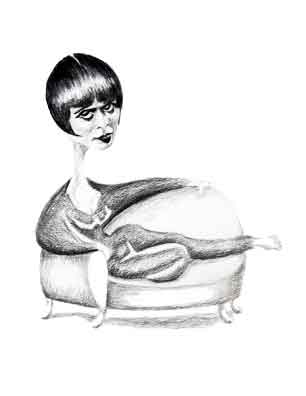(Click Image to Zoom In and Out.)
The era of the silent movies lasted from 1894 to 1929. Well, maybe it was from 1906 to 1930. Or was it from 1915 to 1936?
Well, if you want to get technical, the earliest motion picture as we know them was filmed in 1888. That picture was, of course, silent. The last commercially released - and successful - silent film was in 1976. That was the Mel Brooks film Silent Movie. But critics will point out this picture is actually a "spoof" of silent movies and with the sound effects included - and one spoken word - it isn't really silent.
As far as the first talking picture - that is, when a character on the screen actually said something that the audience heard - it was not The Jazz Singer. Instead it was the introduction to Don Juan a film presenting various musicians, singers, and dancers, filmed for the Vitaphone films produced by Warner Brothers. There the President of the Motion Picture Producers and Distributors of America, William Hays, gave a short speech in a very slow deliberate manner. This was in 1926.
But the consensus is that the first full length feature film with spoken dialog was in 1927 and yes, it was The Jazz Singer. For all practical purposes The Jazz Singer killed the silent films. But Modern Times, written by Charlie Chaplin, directed by Charlie, Chaplin, and produced by Charlie Chaplin - oh, yes, and starring Charlie Chaplin - was released in 1936. Although there was a soundtrack, it was still a silent movie by any definition of the genre.
One of the biggest stars of the silent era was Clara Bow whose real name was - Clara Bow. Her story is itself almost like a Hollywood movie. She came from an unhappy home, won a casting contest sponsored by a magazine, and was selected for a minor part in the 1922 movie, Beyond the Rainbow. She stayed in Hollywood and after some time began landing regular roles. Her big break came in 1927 when she was cast as the lead part in "IT" The plot is rather involved but ultimately the "IT" girl - Clara - lands the guy.

Louise Brooks
As her fame grew Clara became the picture of the quintessential "flapper", the liberated woman of the 1920's along with the likes of Louise Brooks, Colleen Moore, or Norma Talmadge. But she also played a more serious minded woman in the war movie Wings. Then in 1928 she was cast alongside Frederick March, then one of Hollywood's biggest leading men, in The Wild Party.
Critics debate why Clara never became a household word like many of her contemporaries. The opinions range from her Brooklyn accent was unsuited to the sound films of the time to her off-camera partying lifestyle didn't fall in with the Hollywood public relations departments who sometimes demanded "morality" clauses in their stars' contracts. True, unlike many silent stars who successfully transitioned to sound, Clara began acting directly in movies but without prior stage elocution experience. Nevertheless, she still appeared in over 10 talkies from 1929 to 1933 which belies the idea her voice was too rough for the new genre. And if some tales are believed, a lot of other movie stars liked the high life. But whatever the reasons, Clara retired from acting after 1933, and moved to a ranch in Nevada with her husband, the western film star, Rex Bell. Although Rex later went into politics, he still acted from time to time and his last movie was The Misfits which was also the last movie of two other actors, Clark Gable, and another "IT" girl, Marilyn Monroe.
References and Further Reading
Clara Bow: Runnin' Wild, David Stenn, Doubleday, 1988
"Clara Bow: The Hard-Partying Jazz-Baby Airbrushed from Hollywood History", Pamela Hutchinson, The Guardian, June 21, 2016.